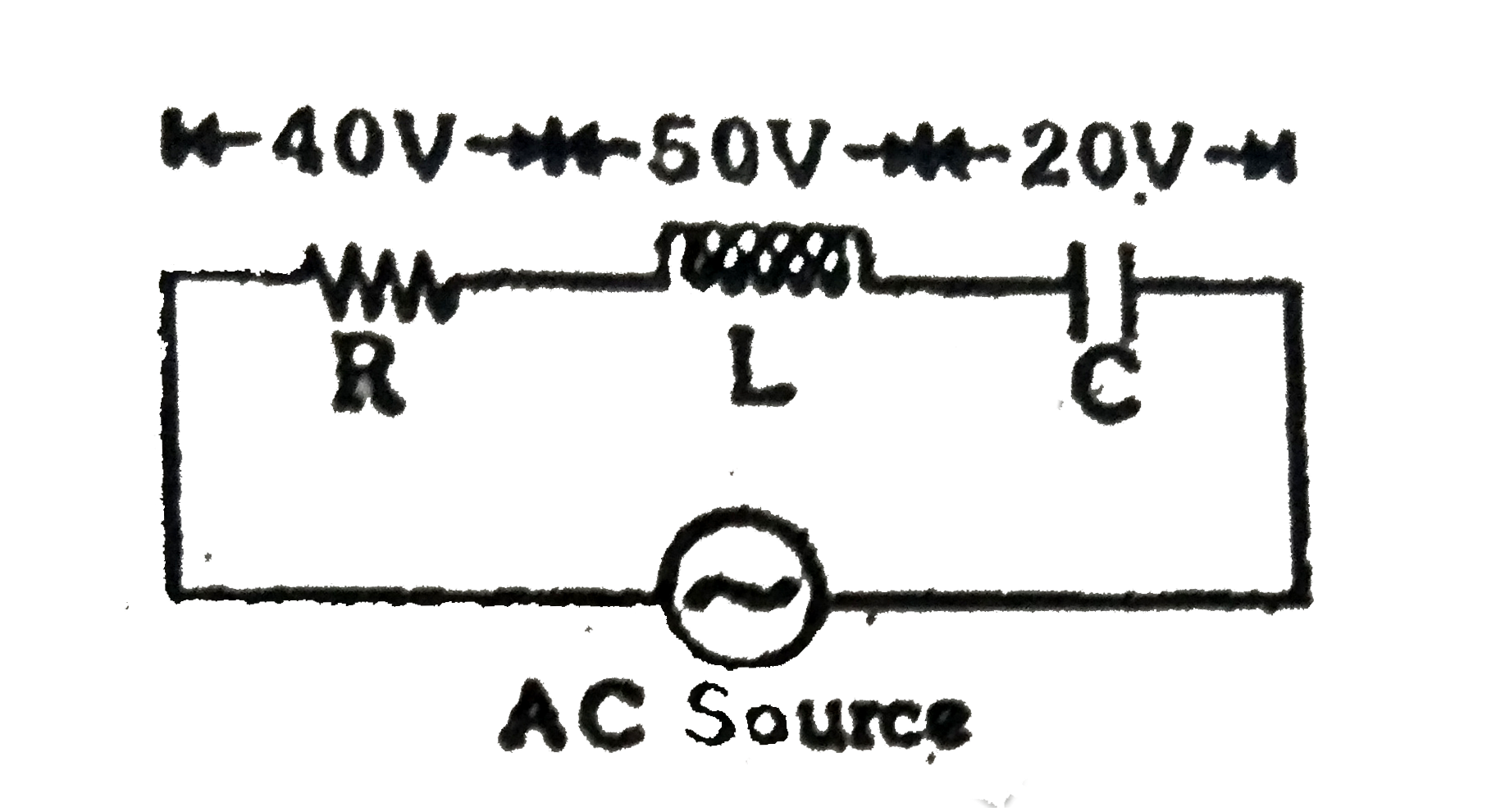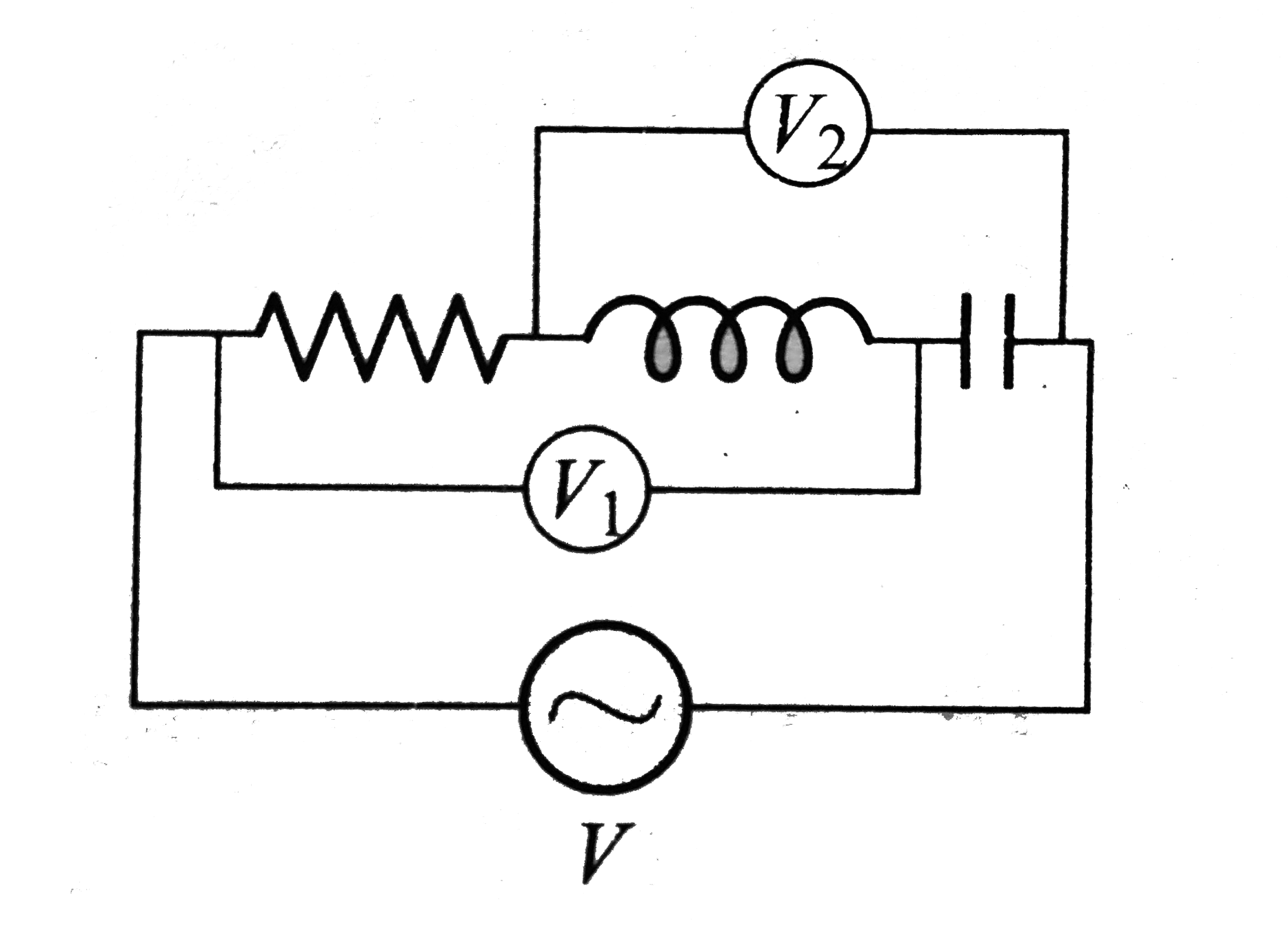In an LCR series ac circuit the voltage across L,C and R are V1,V2 and V3 respectively The voltage of the source is .
equal to V1+V2+V3
equal to V1−V2+V3
more than V1+V2+V3
none of these is ture
The correct Answer is:D
To find the voltage of the source in an LCR series AC circuit, we can use the relationship between the voltages across the inductor (L), capacitor (C), and resistor (R). The voltages across these components are represented as V1, V2, and V3 respectively.
1. Identify the voltages across each component:
- Let VL=V1 (voltage across the inductor)
- Let VC=V2 (voltage across the capacitor)
- Let VR=V3 (voltage across the resistor)
2. Understand the phasor relationship:
- In an LCR series circuit, the voltages do not simply add up algebraically due to their phase differences. The voltage across the inductor and capacitor are out of phase by 180 degrees.
3. Apply the formula for the total voltage:
- The total voltage of the source V can be calculated using the formula:
V=√(VL−VC)2+V2R
- This formula accounts for the phase difference between the voltages across the inductor and capacitor.
4. Substitute the values:
- Substitute VL, VC, and VR into the formula:
V=√(V1−V2)2+V23
5. Conclusion:
- The voltage of the source in the LCR series AC circuit is given by:
V=√(V1−V2)2+V23
- Let VL=V1 (voltage across the inductor)
- Let VC=V2 (voltage across the capacitor)
- Let VR=V3 (voltage across the resistor)
- In an LCR series circuit, the voltages do not simply add up algebraically due to their phase differences. The voltage across the inductor and capacitor are out of phase by 180 degrees.
- The total voltage of the source V can be calculated using the formula:
V=√(VL−VC)2+V2R
- This formula accounts for the phase difference between the voltages across the inductor and capacitor.
- Substitute VL, VC, and VR into the formula:
V=√(V1−V2)2+V23
- The voltage of the source in the LCR series AC circuit is given by:
V=√(V1−V2)2+V23
Topper's Solved these Questions
- BOOK - RESONANCE ENGLISHCHAPTER - ALTERNATING CURRENTEXERCISE - SECTION D: Resonance10videos
ALTERNATING CURRENT
- BOOK - RESONANCE ENGLISHCHAPTER - ALTERNATING CURRENTEXERCISE - SECTION E:6videos
ALTERNATING CURRENT
- BOOK - RESONANCE ENGLISHCHAPTER - ALTERNATING CURRENTEXERCISE - SECTION B15videos
ALTERNATING CURRENT
- BOOK - RESONANCE ENGLISHCHAPTER - ATOMIC PHYSICSEXERCISE - Advanved level problems17videos
ATOMIC PHYSICS
Similar Questions
In an L-C-R circuit the AC voltage across R, L and C comes out as 10 V , 10 V and 20 V respectively . The voltage across the enter combination will be
View SolutionIn an LCR series ac circuit , the voltage across each of the components , L,C and R is 50 V . The voltage across the LC combination will be :
View Solution
Knowledge Check
- Question 1 - Select One
In a series LCR circuit the voltage across an inductor, capacitor and resistor are 20 V, 20 V and 40 V respectively. The phase difference between the applied voltage and the current in the circuit is
A30∘B45∘C60∘D0∘
In a series LCR circuit, the the rms voltage supply is 170 V. If VR,VLandVC represent the rms voltage drop across resistor , inductor and capacitor, then
View SolutionIn series LCR circuit, the voltages across R, L and C are shown in the figure. The voltage of applied source
 View Solution
View SolutionIn an RLC series circuit shown in fig. the reading of voltmeters (V1)and(V2) are 100 V and 200 V respectively. The source voltage is 130 V. for this situation, mark out the correct statements (s).
 View Solution
View SolutionIn a series resonant circuit, the ac, voltage across resistance R, inductance L and capacitance are 5V, 10V and 10V, respectively. The ac. voltage applied to the circuit will be
View SolutionIn a series LCR circuit, the voltages across an inductor, a capacitor and a resistor are 30 V, 30 V, 60 V respectively. What is the phase difference between the applied voltage and the current in the circuit ?
View SolutionIn a series LCR circuit, the voltages across an inductor, a capacitor and a resistor are 30 V, 30 V, 60 V respectively. What is the phase difference between the applied voltage and the current in the circuit ?
View SolutionIn a series L.C.R. circuit, the potential drop across L, C and R respectively are 40V, 120V and 60V . Them the source voltage is
View Solution
